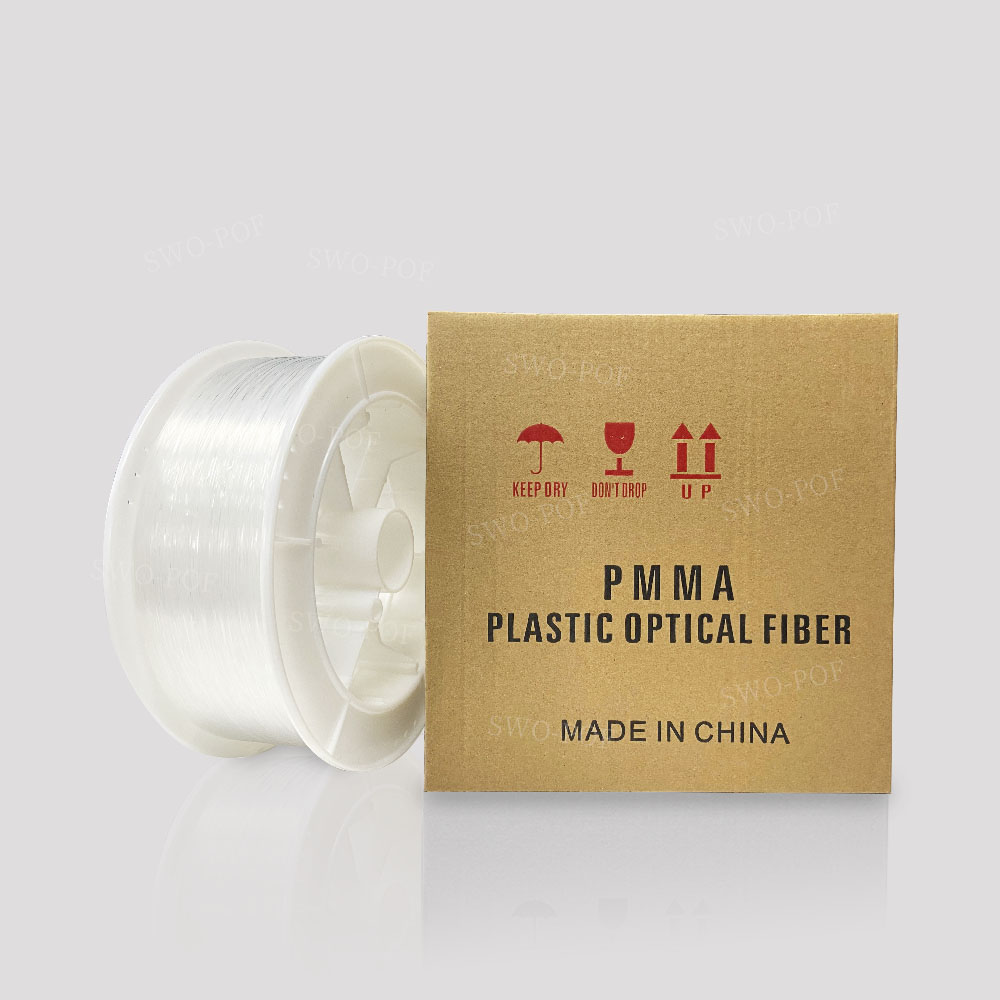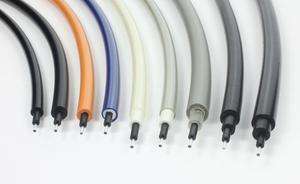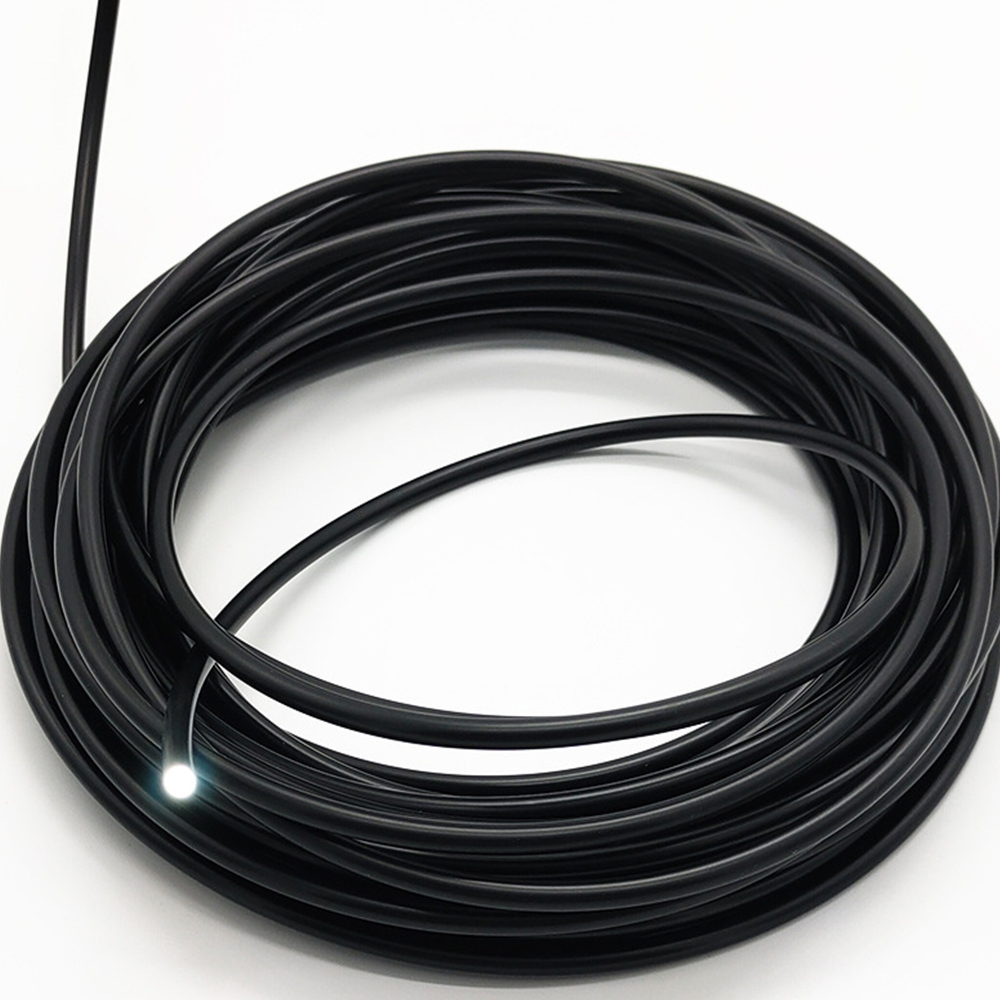Plastic optical fiber (POF) and bare fiber are two common types in the field of optical fiber, but the material properties, application scenarios and costs of the two are significantly different. This article analyzes the differences and applicable scenarios of the two from three dimensions: core material differences, performance parameter comparison and typical application scenarios.

The bare fiber of plastic optical fiber is composed only of a core layer (PMMA material) and a cladding layer, and its diameter is usually between 0.5-2 mm, like an extremely thin and transparent polymer fiber; while ordinary plastic optical fiber (optical cable) will wrap PVC, PE or thermal insulation sheath outside the bare fiber, with a diameter of 2-5 mm, which is like "putting on a bulletproof vest" for the optical fiber.
The bending radius of the bare fiber needs to be ≥25mm (about the diameter of a ping-pong ball), and excessive bending can easily lead to internal optical path breakage. The outer sealing design of the sheathed optical fiber can reduce the bending angle to 15mm (about the width of the thumb), and it can even be wrapped around the robot arm for dynamic operation.
Bare fiber is only suitable for dry, frictionless indoor environments, such as laboratory optics or inside electronic equipment. Sheathed optical fiber can cope with harsh conditions such as oil pollution, vibration, ultraviolet light exposure, and can be directly used in vehicle production lines or outdoor electronic engineering.
Because there is no interference from the sheath material, the bare fiber has a loss of only 150-180dB/km during short-distance transmission (within 50 meters), which is suitable for high-precision signal transmission. Although the loss of the sheathed optical fiber is slightly higher (180-250dB/km), the outer layer protection can reduce the signal fluctuation caused by external forces, and long-distance transmission is more documented.
The price of bare fiber is 30%-50% lower than that of sheathed fiber. The price of 1mm diameter bare fiber is about ¥0.08-0.12 yuan/meter, which is suitable for short-distance projects with insufficient budget. Because the production process is more complicated, the price of ordinary sheathed optical cable ranges from 1 yuan to 5 yuan per meter, but it can reduce subsequent maintenance costs. .
Bare fiber installation needs to avoid scratching the surface, usually with special cutting knives and couplers, and has high technical requirements for operators. The equipped reinforcement core and the connecting end support direct installation, so that the sheathed optical fiber can be laid directly. This technology can be easily implemented by ordinary electricians. .

Typical use: endoscope imaging fiber, blood glucose monitor optical path
Advantage: The diameter can be 0.3mm (about 3 hairs thick, or even lower, flexible bending does not damage human tissue
Case data: A domestic endoscope brand uses 0.5mm bare fiber, and the imaging clarity is improved by 40%
Typical use: Spectrum analyzer, laser transmission experiment
Advantage: 650nm wavelength transmittance ≥92%, ensuring the accuracy of experimental data
Measured comparison: Bare fiber signal noise is 15dB lower than sheathed fiber
Typical uses: LED light guides for smart speakers, image transmission of AR glasses
Advantages: Low cost (optical fiber cost per device <¥0.5 yuan) + easy processing (can be cut with ordinary hot knives)
Industry trends: Global demand for bare fiber for consumer electronics will increase by 23% in 2023
Scenario 4: Short-distance transmission of industrial sensors
Typical uses: Temperature sensing of CNC machine tools, signal feedback of AGV vehicles
Advantages: Resistant to low temperatures of -40℃, and 100 times the anti-electromagnetic interference ability of copper wire
Life test: Continuous work for 5,000 hours in a vibration environment, and the loss only increases by 2%

Short transmission distance (<100 meters)
Environment without oil pollution/friction
Budget less than ¥10 yuan/meter
Outdoor waterproof/high temperature resistance (>85℃) is required
The wiring path has sharp bends
Equipment needs to be frequently plugged in and out and moved
Some inferior bare fibers are made of recycled plastics with a light transmittance of <85%. They can be tested with a mobile phone flashlight - the light spot of high-quality bare fibers is uniform and has no dark patterns.
Require the manufacturer to provide the "IEC60793-2-40 Test Report", focusing on the "attenuation coefficient" and "tensile strength" data.
If the bare fiber must be exposed for use, it can be covered with a corrugated tube, which is not expensive and can effectively prevent mice from gnawing and extend its life.
The bare plastic fiber and the sheathed plastic fiber are like "lightly armed" and "fully armed" soldiers. There is no absolute advantage or disadvantage, only the difference in applicable scenarios. It is recommended to select manufacturers who provide samples and provide training explanations, such as Senwo Technology, to meet the requirements based on the actual test results.
CopyRight © Senwo technology . All Rights Reserved TEL:+86-717-4828268 网站地图